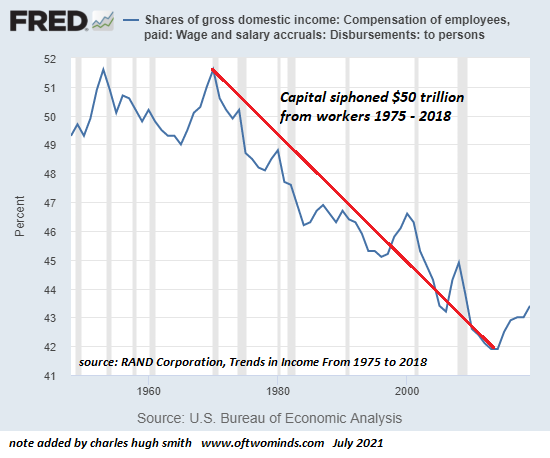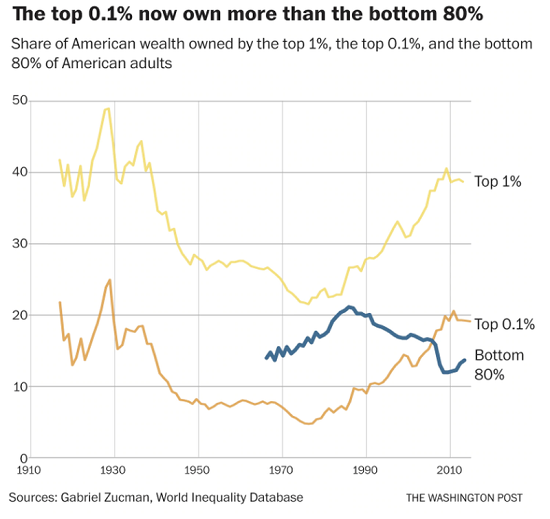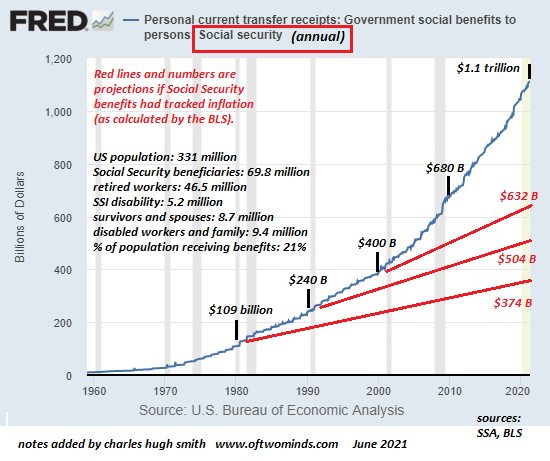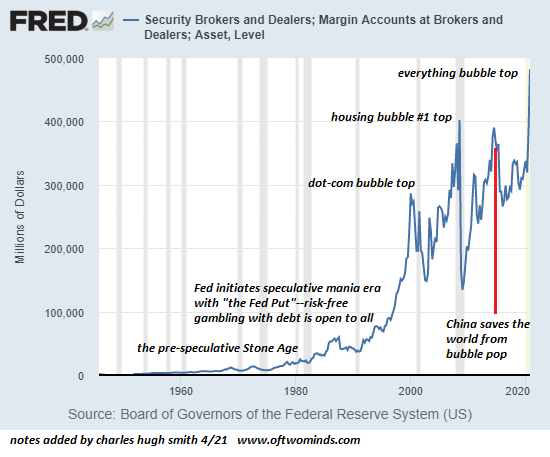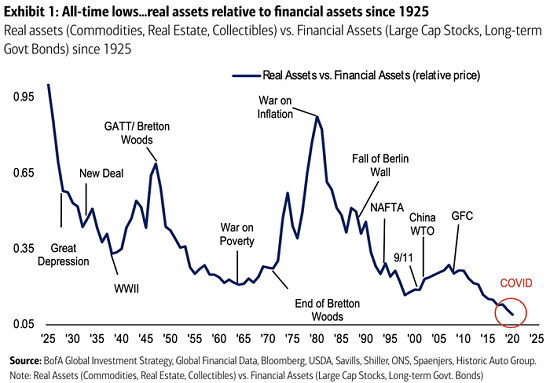Great swaths of the American workforce are already on strike or slipping away from the dead-end treadmill. America’s labor shortage is complex and doesn’t lend itself to the simplistic expectations favored by media talking heads. The Wall Street cheerleaders extol the virtues of “getting America back to work” which is Wall-Street-speak for getting back to exploiting workers to maximize corporate profits. Long-term demographics have combined with cultural changes and Covid-Lockdown epiphanies to completely re-order America’s labor force beneath the superficial surface of “re-opening.” No one post can do justice to such a complex topic, so I’ll touch on a few of the many inter-connected (and often mutually reinforcing) dynamics. 1. Boomers are leaving the workforce
Topics:
Charles Hugh Smith considers the following as important: 5) Global Macro, 5.) Charles Hugh Smith, Featured, newsletter
This could be interesting, too:
RIA Team writes The Importance of Emergency Funds in Retirement Planning
Nachrichten Ticker - www.finanzen.ch writes Gesetzesvorschlag in Arizona: Wird Bitcoin bald zur Staatsreserve?
Nachrichten Ticker - www.finanzen.ch writes So bewegen sich Bitcoin & Co. heute
Nachrichten Ticker - www.finanzen.ch writes Aktueller Marktbericht zu Bitcoin & Co.
Great swaths of the American workforce are already on strike or slipping away from the dead-end treadmill.
America’s labor shortage is complex and doesn’t lend itself to the simplistic expectations favored by media talking heads. The Wall Street cheerleaders extol the virtues of “getting America back to work” which is Wall-Street-speak for getting back to exploiting workers to maximize corporate profits.
Long-term demographics have combined with cultural changes and Covid-Lockdown epiphanies to completely re-order America’s labor force beneath the superficial surface of “re-opening.” No one post can do justice to such a complex topic, so I’ll touch on a few of the many inter-connected (and often mutually reinforcing) dynamics.
1. Boomers are leaving the workforce in droves. The statistics are incomplete but we know that a larger percentage of Boomers have been working longer than previous generations. A Pew Research 2018 study documents this:
Baby Boomers are staying in the labor force at rates not seen in generations for people their age.
Now Boomers are leaving the workforce. Some are retiring, i.e. qualifying for pensions and/or Social Security benefits, while many others who have been drawing retirement benefits while they continued working are quitting the workforce. A November 2020 report discusses this reversal:
The pace of Boomer retirements has accelerated in the past year: (pewresearch.org)
This is 3.2 million more Boomers than the 25.4 million who were retired in the same quarter of 2019.
According to the Social Security Administration, around 3.2 million workers signed on for their Social Security retirement benefits in 2019, and around 2.7 million more people qualified for disability benefits or as dependents of retirees or disabled workers. Fast Facts & Figures About Social Security, 2020
That may not seem like a lot of people out of a workforce of around 160 million. But recall that millions of Boomers have been working into their 60s and 70s. The number of those workers who have retired for good is unknown, but anecdotally, it is consequential.
(Social Security reports 178 million people had some income that qualified for Social Security, but around 20 million of these incomes are extremely low: eBay sellers, occasional gig workers, etc. earning a few hundred or few thousand dollars a year. The primary workforce is around 160 million people.)
Why have they left? They’re fed up with their line of work, they don’t like the way their industry has transmogrified, they’re burned out from being “sandwiched” between caring for very elderly parents (80 and older) and supporting their children or grandchildren, and they’re tired of working after 50+ years. (I myself have logged 51 years of employment.)
2. There aren’t enough skilled replacements for experienced hands-on workers who have left the workforce. Here’s what the superficial analyses miss: what matters isn’t the total number of people seeking jobs or the job openings–what matters is how many people are able to replace skilled workers who have left the workforce and are willing to work for the wages being offered.
In other words, there may be 10 million people available for work but if few have the requisite skills and experience, then 1.5 million openings for welders, pipefitters, crane operators, etc. will go begging, and a bidding war will jack up wages for the scarce qualified workers.
Culturally, the push to make every young worker a college graduate has left the nation shorthanded in skilled hands-on tradecraft workers of the sort that actually keep the nation running. If everyone wants to be a celebrity chef, social media influencer, software guru, YouTube star, environmental studies major, RobinHood millionaire speculator, etc., then it’s no surprise that there are insufficient experienced replacement workers for the nation’s aging workforce of skilled trade workers and technicians that keep the power lines, refineries, chemical plants, water treatment facilities, electrical grid, plumbing, etc., functioning– to name just a few of the hundreds of skilled crafts that are losing much of their aging workforce to retirement.
There are no 100-day wonders in these fields. It takes years of training and experience to master these trades.
3. The pandemic lockdown provided tens of millions of workers with an epiphany about their lives, careers, values and aspirations. This reckoning has overturned many of the assumptions being made about the Gen-X and Millennial workforce.
Recall that the economy is a self-organizing, emergent system of millions of individual assessments and decisions. On a larger scale, what we see is unprecedented turnover as over 4 million workers are quitting their jobs every month. The reasons are varied–burnout from insane workloads, rage-quitting over intolerable working conditions, absurd demands from Corporate HQ and having had enough of being cussed out by customers, and seeking better opportunities elsewhere–but the bottom line is work in America is undergoing a revolution few want to recognize because it’s changing the terms of the exploitation the status quo holds so dear.
What YOLO (you only live once) and FIRE (financial independence, retire early) are telling us is that work is often misery in America. The FIRE proponents are saying we don’t want to slave away our entire lives to pay debt, enrich billionaires cavorting in self-glorification and over-consume in a waste-is-growth wasteland.
By setting the goal of exiting the workforce at 35, they’re saying they don’t want to work 30 additional years for nothing of any real value.
YOLO (you only live once) has many manifestations, but it boils down to “there has to be a better way to live than this.” This includes avenues from trying to amass a fortune in daytrading to cobbling together side hustles to building a micro-house and getting by on a fraction of middle-class expenses to starting an enterprise on one’s own terms.
Keeping YOLO and FIRE inspired workers on the dead-end treadmill of stagnant wages is not going to work. To entice these escapees back to the grinding wheel is going to take much higher pay and levels of employee empowerment Corporate America hasn’t the foggiest idea about.
4. America is profoundly unhealthy, diminishing the workforce in ways few dare to consider. Fully 10% of the workforce is on permanent disability. Some are free-riders, of course, but most have real health issues.
Unfit for Work: The startling rise of disability in America (NPR)
America’s health problems extend from mass addiction to drugs, porn and social media to the physical decay of poor diets and low levels of fitness. To ignore the impact of chronic poor health on the workforce is to cling to an absurdly high level of denial.
Bottom line: the workforce is shrinking as poor health sweeps millions into disability or low levels of participation in the economy. Employers will have to raise wages to attract healthy, productive workers.
| 5. America’s economy and society no longer have roles for millions of average workers. In past generations, there were undemanding we just need a warm body jobs for people who for whatever reason were not up to being the super-productive, super-motivated worker of Corporate America’s dreams.
There are few undemanding jobs left in America. Every job is demanding, regardless of pay. Fast-food, hospitality, janitorial, agricultural work–all are highly demanding. Many people simply don’t have what it takes to work under unrelenting pressure for 8+ hours a day. Many others are unfit for physically demanding work. The fantasy is that all workers are clay that can be shaped into the ideal worker with sufficient training and motivational rah-rah. The reality is America’s family structure has failed in many cases, its educational system has failed in many cases, its War on Drugs Gulag has failed, its so-called safety net has failed in many cases, and as a result a great many people are incapable of demanding work of the kind every employer now needs. |
Wages Shares, 1960 - 2021 |
| 6. The pendulum of exploitation and wealth/income inequality has reached an extreme that is now reversing. As noted yesterday, when you push the pendulum to an extreme of inequality, it will swing to the opposite extreme minus a tiny bit of friction.
This will lead to types of labor disorder that are currently unthinkable for the mainstream punditry, for example, wildcat strikes at fulfillment centers and Big-Box outlets and the enraged trashing of symbols of Corporate/Financier/Wall Street excess. Add all this up and the conclusion is revolutionary: great swaths of the American workforce are already on strike or slipping away from the dead-end treadmill. The terms of employment will have to change dramatically, and that will drive inflation higher–or savage corporate profits–take your pick. Few see this now but they’ll be forced to recognize it soon enough. If you doubt this, check back in 2025. |
Wealth Inequality, 1910 - 2020 |
Tags: Featured,newsletter

